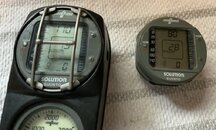georgec02
Registered
Hi all,
I have an Aeris Atmos 1 wrist-mount puck. The thing's probably at least 15 years old by now. It still works, I have extra o-rings for it and it has never given me any problems. We just do regular recreational diving, no nitrox.
Is there any reason why I'd need (not want ) to replace a dive computer from a safety perspective (assuming it meets all my needs and is functional/reliable)?
) to replace a dive computer from a safety perspective (assuming it meets all my needs and is functional/reliable)?
Though my kids are getting certified this month so that might be an excuse to get my wife and I new computers this year...
Thanks all!
I have an Aeris Atmos 1 wrist-mount puck. The thing's probably at least 15 years old by now. It still works, I have extra o-rings for it and it has never given me any problems. We just do regular recreational diving, no nitrox.
Is there any reason why I'd need (not want
Though my kids are getting certified this month so that might be an excuse to get my wife and I new computers this year...
Thanks all!




